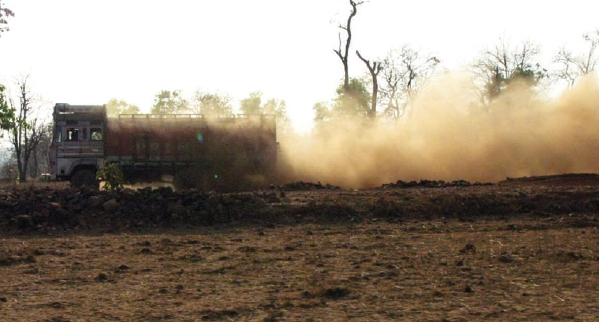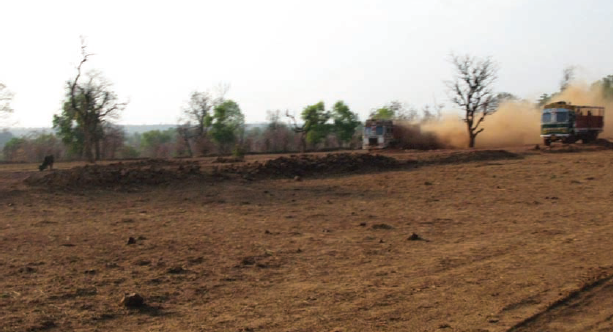Bharat Aluminium Company Limited (BALCO), which is a Public Sector Undertaking, received an environmental clearance in 2003 for bauxite mining in the Kabirdham district of Chhattisgarh. Since the mine became operational in 2003, there have been studies and media reports which have highlighted instances of non-compliance of environmental safeguards. There have also been complaints by affected villagers about impacts from mining and other ancillary operations.

In this context, Janabhivyakti, along with Centre for Policy Research-Namati Environmental Justice Program and Oxfam India, initiated a groundtruthing process in 2018 to understand the impacts of this project on the people, which are linked to the non-compliance of Environmental Laws. Vanvasi Kisan Mazdoor Vikas Samiti from Bodai-Daldali also collaborated in identifying the impacts and outreach amongst the affected people.
Excerpts from the chapter “Reported Impacts and Evidence of Violations” in the study “Closing the Enforcement Gap: Groundtruthing of Environmental Violations in Bodali-Daldali, Chhattisgarh”, prepared by researchers of the CPR-Namati Environmental Justice Program:
Dust Pollution due to transportation, drilling and blasting
Violation of specific condition 5.A. (xi), (xvii), (xviii), (xix) general condition number 5.B. (iii) of the EC dated 09.04.2010, terms and condition number 4, 6, 7 and 8 of the CTO and 5,9 and 10 of the renewed CTO.
Dust pollution was an important concern that was raised during the village level meeting. It was identified that the drilling and blasting process for the extraction of the ore and the transportation of the ore was all resulting in a lot of dust being generated in the area.
Some major issues were:
- Blasting is carried out in the mining pits that are located very close to the habitations. People have stated that small boulders often fly out and land either near or on houses. This is in addition to the dust that is generated as a result of the blasts that take place.
- Drilling results in a spiral of dust being generated and since there is no mitigation measure in place, the dust enters the homes and a red layer is seen in several places as a result of the dust.
- The road used to transport the ore within the mining lease premise is not black topped and hence susceptible to large amounts of dust getting deposited. As vehicles move along this road, clouds of red dust can be seen.
- The 42 km long road from Bodla to Daldali serves the dual purpose of transporting minerals and is also used by people to reach the nearby towns. With open trucks transporting tons of bauxite on the very same road, the road has been riddled with potholes. It was stated by the people that during the summer and winter months a layer of red dust covers the roads where the trucks ply, the monsoon sees the dust mix with the water and fill up the potholes with mud. Resultantly, local transportation through the road becomes quite difficult.
As per the conditions given in the EC, the company is supposed to conduct regular monitoring of the air quality levels. However, evidence from investigations done by the Comptroller and Auditor General (CAG) and the Regional Office (RO) of the MoEFCC show that regular assessment of AAQ was not being done. The CAG had done a joint inspection of the Daldali Bauxite mine with officials from BALCO in May 2016. The inspection had observed that there was no assessment being done of the ambient air quality in the mine.

The same was also noted by a site inspection carried out by the Regional Office of the MoEFCC at Nagpur in January 2017, wherein it was observed that the AAQ was not being regularly updated, the data on it was from May 2016, and there were no display boards on the site. Conditions in the CTO mandate the company to cover vehicles while transporting. However, we obtained photographic evidence showing uncovered trucks plying along the Bodla-Daldali road. Additionally, the monitoring report of the MoEFCC Regional Office, prepared on the basis of the site visit in January 2017, had observed that uncovered trucks were being used to transport the ore.
Backfilling of the mined out pits and subsequent reclamation of land
Violation of Specific Condition 5A (ii) of the EC dated 09.04.2010, Specific Conditions 5A (vii) and (viii) of the EC dated 2003, terms and condition no 16 and 21 of the CTO and terms and condition no 11 of the renewed CTO.
Prabhu, a resident from Mundadar, which is one of the four core villages, wants back the piece of land that he lost as a result of the operation of the mine. According to him, the members from the Vanvasi Kisan Mazdoor Vikas Samiti have discussed with the state authorities that all land that has been mined out should be reclaimed and given back to the land owners. There exists nothing on official records however as to how or in what condition the land will be returned.
Linked to this, the following problems were discussed during the meeting that took place in August 2018:
- The void pits are not backfilled properly and it is unsafe for both children and cattle who live near around the mining pits, and are susceptible to fall in.
- Although in some of the mined out pits the overburden had been used to fill up the pits, the land has not been levelled and the top soil has not been used to cover the soil to prepare the land for plantation/agriculture.
The six-monthly compliance report dated 23.11.2018, for the months April 2018-September 2018 specifies that the overburden soil is being concurrently backfilled, but photographs, Google Earth images collected by the research team in 2018 of the mine lease area show barren lands with upper laterite, no top soil and no plantation. The images also show the abandoned void pits and some backfilled pits with no top soil reclamation. However, this has not been noted in any official documents, which is perhaps why the problem continues to persist.

Not only has the project proponent not taken any steps in furtherance of reclaiming the land, the conditions stipulated in the EC dated 04.12.2003 require that it undertake extensive afforestation. A collective reading of specific conditions (vii) and (viii) reveals that the entire mine lease area is required to be afforested. During an inspection of the mine carried out in May 2016 by the Comptroller and Auditor General (CAG), it was observed that the approved mining plan required for the voids of the mined out pits to first be levelled with overburden soil and thereafter plantation was required to be carried out at the rate of 1000 trees per hectare. Plantations are not visible in the Google Earth images that have been collected by the research team, and the land use change in Bodai-Daldali from 2001-2018 can be found in Annexure I of the report.
Health hazards and threat to life of labourers working in the mine
Violation of specific condition number (xxii) and general condition number (vii) of Environmental Clearance and terms and condition number 20 of Consent to Operate.
The mining operations have affected the livelihood of the villagers. In order to secure alternate means of the same, the villagers, both tribal and non-tribal were engaged as labour in the mining operations. It was discussed during the second meeting in August 2018 that those who were working in the mine be provided with few safety gears such as helmets, gloves and shoes. However, there was very little awareness amongst the labourers regarding what was to be done with the protective gear. Thus, they did not know what to do with the earplugs or the helmets and were unaware of their importance. Consequently, none of the gear was being used.
It was reported that workers use their bare hands to first hammer the ore into small parts and then load the mineral on to the trucks. They did not have any shoes on. Despite them not using even the most basic safety gears, they were allowed to work without any protective measures. This had also been documented in a video put together by Mines and Communities in 2016 in which the actual working conditions in the mine were juxtaposed to a video prepared by BALCO which showcased the state of the labourers working in the mine.16 The actual story is what has been recorded by Mines and Communities since even in July 2018, the conditions in which the labourers were engaged in mining were far from satisfactory.
With respect to providing earplugs for those who are engaged in blasting and drilling activities, in 2016, during the inspection by CAG and the Company Officials, it was observed by the audit team that no earplugs had been provided to the workers. Further, in the monitoring report of the RO of the MoEFCC dated 20.3.2017, it was observed that no data pertaining to the details of protective respiratory devices made available to the workers had been provided to the RO.17 Similarly, no details were made available about the particle analysis of the dust generated and the personnel exposure monitoring of the workers to better understand and be able to prevent impacts on the health of workers.
This lack of attention to safety aspects by the workers strongly suggests that there is little effort to ensure training and information-sharing related to the health and safety issues. This points to violation of the conditions given below that are directly linked to worker safety measures.
Courtesy: Counter View
